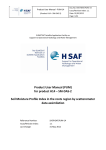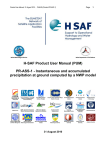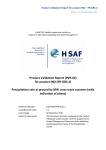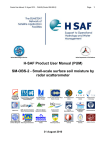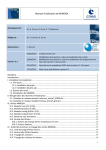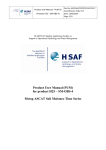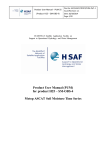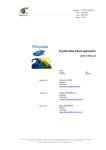Download Product User Manual - H-SAF
Transcript
Product User Manual - PUM-11
(Product H11 – SN-OBS-2)
Doc.No: SAF/HSAF/PUM-11/1.2
Issue/Revision Index: 1.2
Date: 21/10/2013
Page: 1/24
EUMETSAT Satellite Application Facility on
Support to Operational Hydrology and Water Management
Product User Manual (PUM)
for product H11 – SN-OBS-2
SN-OBS-2 - Snow status (dry/wet) by MW radiometry
Reference Number:
Issue/Revision Index:
Last Change:
SAF/HSAF/PUM-11/1.2
1.2
21 October 2013
Product User Manual - PUM-11
(Product H11 – SN-OBS-2)
Doc.No: SAF/HSAF/PUM-11/1.2
Issue/Revision Index: 1.2
Date: 21/10/2013
Page: 2/24
DOCUMENT CHANGE RECORD
Issue / Revision
Date
Description
1.0
16/05/2011
Baseline version prepared for ORR1 Part 2.
Obtained by PUM-11 delivered during the Development Phase.
1.1
30/09/2011
Updates, acknowledging ORR1 Part 2 review board recommendation
1.2
21/10/2013
Version prepared for ORR1 Part4
Product User Manual - PUM-11
(Product H11 – SN-OBS-2)
Doc.No: SAF/HSAF/PUM-11/1.2
Issue/Revision Index: 1.2
Date: 21/10/2013
Page: 3/24
INDEX
1
Introduction .............................................................................................................................................. 5
1.1
Purpose of the document .................................................................................................................. 5
1.2
Introduction to product SN-OBS-2 .................................................................................................... 5
1.2.1
Principle of sensing .................................................................................................................... 5
1.2.2
Status of satellites and instruments .......................................................................................... 6
1.2.3
Highlights of the algorithm ........................................................................................................ 7
1.2.4
Architecture of the products generation chain ......................................................................... 8
1.2.5
Product coverage and appearance ............................................................................................ 8
1.3
Comparison between H10 (SN-OBS-1) and H11 (SN-OBS-2) ............................................................. 9
2
Product operational characteristics ........................................................................................................ 10
2.1
Horizontal resolution and sampling ................................................................................................ 10
2.2
Vertical resolution if applicable ....................................................................................................... 10
2.3
Observing cycle and time sampling ................................................................................................. 10
2.4
Timeliness ........................................................................................................................................ 11
3
Product validation ................................................................................................................................... 12
4
Product availability.................................................................................................................................. 12
4.1
Sites ................................................................................................................................................. 12
4.2
Formats and codes .......................................................................................................................... 12
4.3
Description of the files .................................................................................................................... 13
Annex 1. SN-OBS-2 Output description ..................................................................................................... 15
Annex 2. Introduction to H-SAF .................................................................................................................. 16
Annex 3. Acronyms ..................................................................................................................................... 22
Product User Manual - PUM-11
(Product H11 – SN-OBS-2)
Doc.No: SAF/HSAF/PUM-11/1.2
Issue/Revision Index: 1.2
Date: 21/10/2013
Page: 4/24
List of Tables
Table 1 Current status of EOS-Aqua and DMSP satellites (as of March 2010) .................................................. 6
Table 2 Main features of AMSR-E...................................................................................................................... 7
Table 3 Comparison between H10 and H11: summary table.......................................................................... 10
Table 5 Summary instructions for accessing SN-OBS-2 data at the CNMCA site ............................................ 14
Table 6 Summary instructions for accessing SN-OBS-2 data at the FMI site .................................................. 14
Table 7 H-SAF Product List............................................................................................................................... 18
Table 8 Definition of the development status of a product according to EUMETSAT .................................... 18
List of Figures
Figure 1 Geometry of conical scanning for AMSR-E .......................................................................................... 6
Figure 2 Flow chart of the snow status recognition processing chain .............................................................. 7
Figure 3 Conceptual architecture of the SN-OBS-2 chain.................................................................................. 8
Figure 4 Snow map as in SN-OBS-2 (upper left) from AMSR-E and SN-OBS-1 (upper right) from SEVIRI. 24-h
composite. 22 January 2010. Snow map as in SN-OBS-2 (lower left) from AMSR-E and SN-OBS-1 (lower
right) from SEVIRI. 24-h composite. 09 March 2010 ....................................................................................... 9
Figure 5 - Structure of the Snow products validation team ............................................................................ 12
Figure 6 Conceptual scheme of the EUMETSAT Application Ground Segment .............................................. 16
Figure 7 Current composition of the EUMETSAT SAF Network (in order of establishment) .......................... 17
Figure 8 Logic of the incremental development scheme ................................................................................ 19
Figure 9 Required H-SAF coverage: 25-75°N lat, 25°W - 45°E ......................................................................... 20
Figure 10 H-SAF central archive and distribution facilities.............................................................................. 21
Product User Manual - PUM-11
(Product H11 – SN-OBS-2)
Doc.No: SAF/HSAF/PUM-11/1.2
Issue/Revision Index: 1.2
Date: 21/10/2013
Page: 5/24
1 Introduction
1.1
Purpose of the document
Product User Manuals are available for each (pre)-operational H-SAF product, for open users, and also for
demonstrational products, as necessary for beta-users.
Each PUM contains:
Product introduction: principle of sensing, Satellites utilized, Instrument(s) description, Highlights of the
algorithm, Architecture of the products generation chain, Product coverage and appearance;
Main product operational characteristics: Horizontal resolution and sampling, Observing cycle and time
sampling, Timeliness;
Overview of the product validation activity: Validation strategy, Global statistics, Product
characterisation
Basic information on product availability: Access modes, Description of the code, Description of the file
structure
An annex also provides common information on Objectives and products, Evolution of H-SAF products,
User service and Guide to the Products User Manual.
Although reasonably self-standing, the PUM’s rely on other documents for further details. Specifically:
ATDD (Algorithms Theoretical Definition Document), for extensive details on the algorithms, only
highlighted here;
PVR (Product Validation Report), for full recount of the validation activity, both the evolution and the
latest results.
These documents are structured as this PUM, i.e. one document for each product. They can be retrieved
from the CNMCA site on HSAF web page at User Documents session.
On the same site, to obtain user and password please contact the Help Desk) it is interesting to consult,
although not closely connected to this PUM, the full reporting on hydrological validation experiments
(impact studies):
HVR (Hydrological Validation Report), spread in 10 Parts, first one on requirements, tools and models,
then 8, each one for one participating country, and a last Part with overall statements on the impact
of H-SAF products in Hydrology.
1.2 Introduction to product SN-OBS-2
1.2.1 Principle of sensing
Product SN-OBS-2 (Snow status (dry-wet) by MW radiometry) is based the AMSR-E microwave radiometer
being flown on EOS-Aqua. In case of failure of AMSR-E or of EOS-Aqua, SSM/I and SSMIS flown on the
DMSP satellites will be used (with much worse resolution). These conical scanners provide images with
constant zenith angle, that implies constant optical path in the atmosphere and homogeneous impact of
the polarisation effects (see next figure):
Product User Manual - PUM-11
(Product H11 – SN-OBS-2)
Doc.No: SAF/HSAF/PUM-11/1.2
Issue/Revision Index: 1.2
Date: 21/10/2013
Page: 6/24
Figure 1 Geometry of conical scanning for AMSR-E
Also, conical scanning provides constant resolution across the image, though changing with frequency. It is
noted that the IFOV is elliptical, with major axis elongated along the viewing direction and the minor axis
along-scan, approximately 2/3 of the major. As for the ‘pixel’, i.e. the area subtended as a consequence of
the bi-dimensional sampling rate, the sampling distance along the satellite motion, i.e. from scan line to
scan line, is invariably 10 km, dictated by the satellite velocity on the ground and the scan rate. Along scan,
the sampling rate is 10 km for all channels except 89 GHz where it is 5 km.
The AMSR-E frequencies more sensitive to snow are 18.7 and 36.5 GHz. As a matter of fact, the algorithm
is just a linear combination of these two channels. However, for shallow snow thickness, wet snow cannot
be discriminated from the underlying soil, thus preventive recognition of snow existence by means of SNOBS-1 is necessary before assigning snow status (wet or dry).
The EOS-Aqua satellite is managed by NASA. Direct reception is possible, but AMSR-E data are generally
acquired by ftp from NASA archives. The delay from the observation time is around 6 h, with considerable
fluctuations due to the availability of the NASA ftp server.
The SN-OBS-2 product has been developed in the TKK, and the software was thereafter integrated in the
operational environment of FMI. SN-OBS-2 has a long-standing heritage in Finland where it was validated
since long. The H-SAF generation chain extended the coverage to the whole H-SAF area (Turkey is not
active with SN-OBS-2), ma the product is not tuned to mountainous situations.
1.2.2 Status of satellites and instruments
The current status of EOS-Aqua and of the backup DMSP satellites is shown in next table:
Satellite
EOS-Aqua
DMSP-F15
DMSP-F16
DMSP-F17
DMSP-F18
Launch
End of service Height LST
Status
Instrument used in H-SAF
4 May 2002 expected 2010 705 km 13:30 a
Operational
AMSR-E
12 Dec 1999 expected 2010 845 km 05:40 d Secondary Operation SSM/I (defective) [backup in H-SAF]
18 Oct 2003 expected 2010 855 km 07:10 d Secondary Operation
SSMIS [backup in H-SAF]
4 Nov 2006 expected 2011 855 km 05:30 d
Primary Operation
SSMIS [backup in H-SAF]
18 Oct 2009 expected 2014 857 km 07:55 d
Primary Operation
SSMIS [backup in H-SAF]
Table 1 Current status of EOS-Aqua and DMSP satellites (as of March 2010)
Next table collects the main features of the AMSR-E instrument. Similar tables for SSM/I and SSMIS are
spared. If necessary, they can be found in PUM-01 (Product User Manual for PR-OBS-1, Precipitation rate
at ground by MW conical scanners).
Product User Manual - PUM-11
(Product H11 – SN-OBS-2)
Doc.No: SAF/HSAF/PUM-11/1.2
Issue/Revision Index: 1.2
Date: 21/10/2013
Page: 7/24
AMSR-E
Advanced Microwave Scanning Radiometer for EOS
Satellite
Status
Mission
Instrument type
Scanning technique
Coverage/cycle
Resolution
Resources
EOS-Aqua
Operational - Utilised in the period: 2002 to ~ 2010
Multi-purpose MW imager
Multi-purpose imaging MW radiometer - 6 frequencies / 12 channels
Conical: 55° zenith angle; swath: 1450 km - Scan rate: 40 scan/min = 10 km/scan
Global coverage once/day
Changing with frequency, consistent with an antenna diameter of 1.6 m
Mass: 314 kg - Power: 350 W - Data rate: 87.4 kbps
Central frequency (GHz)
6.925
10.65
18.7
23.8
36.5
89.0
Bandwidth (MHz)
Polarisations
Accuracy (NEΔT)
350
V, H
0.3 K
100
V, H
0.6 K
200
V, H
0.6 K
400
V, H
0.6 K
1000
V, H
0.6 K
3000
V, H
1.1 K
Table 2 Main features of AMSR-E
IFOV
43 x 75 km
29 x 51 km
16 x 27 km
14 x 21 km
9 x 14 km
4 x 6 km
Pixel
10 x 10 km
10 x 10 km
10 x 10 km
10 x 10 km
10 x 10 km
5 x 5 km
1.2.3 Highlights of the algorithm
The baseline algorithm for SN-OBS-2 processing is described in ATDD-11. Only essential elements are
highlighted here.
Here below it is illustrated the flow chart of the SN-OBS-2 processing chain at FMI.
Figure 2 Flow chart of the snow status recognition processing chain
The base for the product is the snow recognition product (see Algorithm Theoretical Definition Document,
ATDD-10), which is used as a marker to find snow regardless of the dryness or wetness. As the snow
recognition product is in different projection, it is reprojected to the 0.25° x 0.25° equal latitude/longitude
grid of the end product. In this stage, the product values "snow" in the snow recognition product is
changed to "wet snow".
Parallel to this, AMSR-E radiometer data are processed. After each new radiometer swath that is
downloaded from NASA ftp, the data are rectified and mosaicked to cover the H-SAF domain. A watermask
is included to the radiometer data, and this is used for the pixels having data. A static watermask is used to
fill in the gaps between different satellite overpasses.
Product User Manual - PUM-11
(Product H11 – SN-OBS-2)
Doc.No: SAF/HSAF/PUM-11/1.2
Issue/Revision Index: 1.2
Date: 21/10/2013
Page: 8/24
These data are fed to the snow status retrieval model to retrieve the pixels with dry snow, and
corresponding pixels in the output are updated to show this status.
In the microwave range, snow emissivity is substantially different for dry and wet snow, therefore snow
status observation is a relatively straightforward application, also facilitated by the all-weather capability.
The emissivity substantially increases when snow is wet, enabling detection of snow status. Middle
frequencies are used (19 and 37 GHz). The recognition of dry snow for snow pack shallower than 80 mm is
unreliable due to high penetration depth of microwaves in dry snow. The algorithm as stand-alone is
unable to discriminate wet snow from bare ground (a problematic issue for mountainous regions), thus wet
snow status is recorded only for those locations where Snow detection (product SN-OBS-1) has revealed
snow or there has been dry snow in the preceding product.
1.2.4 Architecture of the products generation chain
The architecture of the SN-OBS-2 product generation chain is shown in next figure:
EUMETCast
EOS-Aqua
Land SAF
Land SAF snow cover
snow cover
(flat/forested areas)
EUMETCast
EUMETCast reception
FMI
EUMETSAT
Snow cover from
Land SAF
Land Surface
Analysis SAF
Snow detection in
Snow status detection for
flat-forested areas
pixels classified as snow
NASA
AMSR-E ftp site
(SN-OBS-1)
SN-OBS-2
Figure 3 Conceptual architecture of the SN-OBS-2 chain
It is noted that the dependence of product SN-OBS-2 from preventive classification by SN-OBS-1 implies
that the product, although in principle possible to be generated after each EOS-Aqua pass (being AMSR-E
all-weather and available night and day), in practice has to follow the SN-OBS-1 generation rate, i.e. 24
hours. Anyway, the retrieval of data from the NASA archive introduces delays of several hours.
1.2.5 Product coverage and appearance
Next two couple of figures show examples of SN-OBS-2 products and corresponding SN-OBS-1. First one
refers to "deep" winter, with mostly dry snow, second figure showing more melting. Maps are in equal
latitude/longitude grid with sampling intervals of 0.25 degrees.
Product User Manual - PUM-11
(Product H11 – SN-OBS-2)
Doc.No: SAF/HSAF/PUM-11/1.2
Issue/Revision Index: 1.2
Date: 21/10/2013
Page: 9/24
Figure 4 Snow map as in SN-OBS-2 (upper left) from AMSR-E and SN-OBS-1 (upper right) from SEVIRI. 24-h
composite. 22 January 2010. Snow map as in SN-OBS-2 (lower left) from AMSR-E and SN-OBS-1 (lower right) from
SEVIRI. 24-h composite. 09 March 2010
1.3 Comparison between H10 (SN-OBS-1) and H11 (SN-OBS-2)
This section present s a summary of accuracy and sampling limitations of H10 and H11, for short
comparison between the two products.
The results here showed are obtained from the last validation cycle, winter 2009/2010 (i.e. 1st October
2009 - 31 March 2010).
The score are presented as follows:
POD: Probability of Detection
FAR: False Alarm Rate
CSI: Critical Success Index (needed to compare different POD / FAR combinations)
PODF: Probability Of False Detection
ACC: Fraction correct Accuracy
HSS: Heidke Skill Score.
Scores refer only to non-mountainous areas.
Product User Manual - PUM-11
(Product H11 – SN-OBS-2)
Score
N. samples
POD
FAR
CSI
POFD
ACC
HSS
H10 (SN-OBS-1)
10437
0.50
0.10
0.48
0.24
0.55
0.15
Doc.No: SAF/HSAF/PUM-11/1.2
Issue/Revision Index: 1.2
Date: 21/10/2013
Page: 10/24
H11 (SN-OBS-2)
220331
0.75
0.03
0.74
0.02
0.86
0.72
Table 3 Comparison between H10 and H11: summary table
2 Product operational characteristics
2.1 Horizontal resolution and sampling
The horizontal resolution ( x) is the convolution of several features (sampling distance, degree of
independence of the information relative to nearby samples, …). To simplify matters, it is generally agreed
to refer to the sampling distance between two successive product values, assuming that they carry forward
reasonably independent information.
The horizontal resolution descends from the instrument
Instantaneous Field of View (IFOV), sampling distance (pixel), Modulation Transfer Function (MTF) and
number of pixels to co-process for filtering out disturbing factors (e.g. clouds) or improving accuracy. It
may be appropriate to specify both the resolution x associated to independent information, and the
sampling distance, useful to minimise aliasing problems when data have to undertake resampling (e.g., for
co-registration with other data).
For MW conical scanners the IFOV is constant in the image, but depends on the frequency channels utilised
for building the product. Thick snow requires lower frequencies with higher penetration, that implies
coarser resolution. In practise the current algorithm utilises the two frequencies 18.7 and 36.5 GHz, thus
the resolution is that one of AMSR-E at 18.7 GHz, i.e. x ~ 20 km. Sampling is made at 0.25-degree
intervals, i.e., again ~ 20 km.
2.2 Vertical resolution if applicable
The vertical resolution ( z) also is defined by referring to the vertical sampling distance between two
successive product values, assuming that they carry forward reasonably independent information. The
vertical resolution descends from the exploited remote sensing principle and the instrument number of
channels, or spectral resolution. It is difficult to be estimated a-priori: it is generally evaluated a-posteriori
by means of the validation activity.
The only product in H-SAF that provide profiles (below surface) is SM-ASS-1 (Volumetric soil moisture (roots
region) by scatterometer assimilation in NWP model).
2.3 Observing cycle and time sampling
The observing cycle ( t) is defined as the average time interval between two measurements over the same
area. In general the area is, for GEO, the disk visible from the satellite, for LEO, the Globe. In the case of HSAF we refer to the European area shown in Figure 9. In the case of LEO, the observing cycle depends on
the instrument swath and the number of satellites carrying the addressed instrument.
AMSR-E is available only on one satellite, and its swath is 1450 km, thus in principle provides global
coverage every 24 h. Independently on the actual AMSR-E passes over the H-SAF area, the SN-OBS-2
product is generated at 24 hours intervals. Thus the observing cycle is t ~ 24 h.
Product User Manual - PUM-11
(Product H11 – SN-OBS-2)
Doc.No: SAF/HSAF/PUM-11/1.2
Issue/Revision Index: 1.2
Date: 21/10/2013
Page: 11/24
2.4 Timeliness
The timeliness ( ) is defined as the time between observation taking and product available at the user site
assuming a defined dissemination mean. The timeliness depends on the satellite transmission facilities, the
availability of acquisition stations, the processing time required to generate the product and the reference
dissemination means. In the case of H-SAF the future dissemination tool is EUMETCast, but currently we
refer to the availability on the FTP site.
For a product such as SN-OBS-2, resulting by assembling data collected until a fixed time of the day, the
time of observation may change across the scene (some area may have been observed early in the time
window, thus up to 24-h old at the time of dissemination; some very recently, just before product
dissemination). The average timeliness is therefore δ = 12 h.
Product User Manual - PUM-11
(Product H11 – SN-OBS-2)
Doc.No: SAF/HSAF/PUM-11/1.2
Issue/Revision Index: 1.2
Date: 21/10/2013
Page: 12/24
3 Product validation
Whereas the previous operational characteristics have been evaluated on the base of system
considerations (number of satellites, their orbits, access to the satellite) and instrument features (IFOV,
swath, MTF and others), the evaluation of accuracy requires validation, i.e. comparison with the ground
truth or with something assumed as “true”. SN-OBS-2, as any other H-SAF product, has been submitted to
validation entrusted to a number of institutes (see next figure).
Snow parameters validation group
Leader: Finland (FMI)
Belgium
IRM
Finland
Germany
Poland
FMI, SYKE
BfG
IMWM
Figure 5 - Structure of the Snow products validation team
Turkey
METU
The accuracy of the snow status product has been assessed by comparison with meteorological bulletins
and in-field measurements in properly equipped sites. Detailed report of the product validation activity for
product SN-OBS-2 is provided as document:
PVR-11: Product Validation Report for SN-OBS-2.
In this PUM-11 only summary results are provided, mainly aiming at characterising the product quality
under different geographical/climatological conditions (those in the countries of the participating validation
Units).
4 Product availability
4.1 Sites
SN-OBS-2 will be available via EUMETCast (when authorized) and via FTP (after log in).
Currently SN-OBS-2 is available on the following FTP sites (to obtain user and password please contact the
Help Desk):
a. CNMCA site:
URL: ftp://ftp.meteoam.it
directory: products
only current data (at least two months, often more).
b. FMI site:
URL: ftp://ftp.fmi.fi
directory: HSAF
folder: products
all data from April 2008 up to date.
Quick-looks of the last 3 days of SN-OBS-2 maps can be viewed on the H-SAF web site.
4.2 Formats and codes
Two type of files are provided for SN-OBS-2:
the digital data, coded in GRIB-2
the image-like maps, coded in PNG
Product User Manual - PUM-11
(Product H11 – SN-OBS-2)
Doc.No: SAF/HSAF/PUM-11/1.2
Issue/Revision Index: 1.2
Date: 21/10/2013
Page: 13/24
The information to read the GRIB-2 is provided in the FMI site, sub-directory “products”, folder “utilities”,
file “snobs2_grib_to_ascii.tar.gz”. In addition, the output description of SN-OBS-2 is provided in Appendix.
4.3 Description of the files
In the two ftp sites the structure of the records is identical, but the hierarchy is slightly different.
Next two tables, respectively:
summarises the instructions for accessing the data in the CNMCA site;
refers to the FMI site.
Product User Manual - PUM-11
(Product H11 – SN-OBS-2)
Doc.No: SAF/HSAF/PUM-11/1.2
Issue/Revision Index: 1.2
Date: 21/10/2013
Page: 14/24
username: contact password: contact
directory: products
folder: h11
Help Desk
Help Desk
h11_cur_mon_data
Product identifier: h11.
Folders under h11:
h11_cur_mon_png
h11_yyyymmdd_day_FMI.grib2
h11_cur_mon_data
digital data
h11_yyyymmdd_QC_day_FMI.grib2
Files description:
h11_cur_mon_png
h11_yyyymmdd_day_FMI.png
image data
yyyymmdd year, month, day
:
day:
indicates that the product results from multi-temporal analysis over 24 hours (in daylight)
quality control - it records the availability of each data type used in the production, as follows:
QC:
0 - Optical and microwave data have been available and used
1 - Radiometer data has not been available, thus it has not been possible to identify dry snow
2 - Optical data has not been available, thus it has not been possible to identify wet snow
3 - No data available, the product cannot be calculated for this location.
Table 4 Summary instructions for accessing SN-OBS-2 data at the CNMCA site
URL: ftp://ftp.meteoam.it
username: contact
password: contact Help
directory: HSAF
folder: products
Help Desk
Desk
h11_yyyymm_data
digital data monthly packages
Product identifier: h11.
Folders under h11:
h11_yyyymm_images
image data monthly packages
h11_yyyymmdd_day_FMI.grib2
h11_yyyymm_data
digital data
h11_yyyymmdd_QC_day_FMI.grib2
Files description:
h11_yyyymm_images
h11_yyyymmdd_day_FMI.png
image data
yyyymm:
year, month
yyyymmdd: year, month, day
day:
indicates that the product results from multi-temporal analysis over 24 hours (in daylight)
quality control - it records the availability of each data type used in the production, as follows:
QC:
0 - Optical and microwave data have been available and used
1 - Radiometer data has not been available, thus it has not been possible to identify dry snow
2 - Optical data has not been available, thus it has not been possible to identify wet snow
3 - No data available, the product cannot be calculated for this location.
Table 5 Summary instructions for accessing SN-OBS-2 data at the FMI site
URL: ftp://ftp.fmi.fi
Product User Manual - PUM-11
(Product H11 – SN-OBS-2)
Annex 1.
Doc.No: SAF/HSAF/PUM-11/1.2
Issue/Revision Index: 1.2
Date: 21/10/2013
Page: 15/24
SN-OBS-2 Output description
How to convert H-SAF H11 products to ASCII
1) You need GRIB API library, freely available from
http://www.ecmwf.int/products/data/software/download/grib_api.html
2) C++ compiler (tested with g++ versions 3.2.3, 4.1.3, 4.3.3)
3) Download snobs2_grib_to_ascii.tar.gz from ftp://ftp.fmi.fi
4) Uncompress the source code and compile the program with
tar -xzvf snobs2_grib_to_ascii.tar.gz
cd snobs2_grib_to_ascii
g++ -Wall *.cpp -o snobs2_grib_to_ascii -lgrib_api
Depending on the setup of the compilation environment and GRIB libraries, also libjasper may need to
be linked to the program (eg. in Ubuntu based systems). If the GRIB and/or jasper libraries are not in
system directories the installation directories need to be given (adjust to match your system):
If the jasper libraries are not needed separately use the following:
GRIB_INCLUDES=/usr/local/grib_api/inc
GRIB_LIBRARIES=/usr/local/grib_api/lib
g++ -Wall *.cpp -I${GRIB_INCLUDES} -L${GRIB_LIBRARIES} -o snobs2_grib_to_ascii -lgrib_api
If jasper libraries are needed use the following:
GRIB_INCLUDES=/usr/local/grib_api/inc
GRIB_LIBRARIES=/usr/local/grib_api/lib
JASPER_INCLUDES=/usr/include/jasper
JASPER_LIBRARIES=/usr/lib/jasper
g++ -Wall *.cpp -I${GRIB_INCLUDES} -L${GRIB_LIBRARIES} -I${JASPER_INCLUDE}
-L${JASPER_LIBRARIES} -o snobs2_grib_to_ascii -lgrib_api -ljasper
5) Install by typing
./install.sh
and follow instructions. The path where the program is installed has to be in, or added to, the users
$PATH which tells where the operating system searches for executable programs.
Usage:
Change to the directory with the data wanted to be converted to ASCII, and issue command
snobs2_grib_to_ascii -i <file_in.grib2> -o <file_out.txt>
where
file_in.grib2: H-SAF SN-OBS-2 GRIB2 data file
file_out.txt: filename to output the ASCII data
Examples:
- Show help:
snobs2_grib_to_ascii -h
- Decode one file for the whole area:
snobs2_grib_to_ascii -i h11_20080318_day.grib2 -o h11_20080318_day.txt
Product User Manual - PUM-11
(Product H11 – SN-OBS-2)
Doc.No: SAF/HSAF/PUM-11/1.2
Issue/Revision Index: 1.2
Date: 21/10/2013
Page: 16/24
-
Decode a given area subset (40 - 70 degrees latitude, -10 - +30 longitude)
snobs2_grib_to_ascii -i h11_20080318_day.grib2 -o h11_20080318_day.txt -N 70.0 -S 60.0
-W -10.0 -E 30.0
-
Output also NODATA, SPACE and WATER pixels. Decoding with this option it is easier to combine the
product with quality flags!
snobs2_grib_to_ascii -a -i h11_20080318_day.grib2 -o h11_20080318_day.txt
Processing multiple files
Script is provided for processing all the files in the current directory. This script is installed in step 5). NOTE:
if you want to output only a subset of the area, adjust the default values in the beginning of the script.
For example:
cd $HSAF/snobs2/FMI/snobs2_grib_to_ascii_all.sh
Annex 2.
Introduction to H-SAF
The EUMETSAT Satellite Application Facilities
H-SAF is part of the distributed application ground segment of the “European Organisation for the
Exploitation of Meteorological Satellites (EUMETSAT)”. The application ground segment consists of a
“Central Application Facility (CAF)” and a network of eight “Satellite Application Facilities (SAFs)” dedicated
to development and operational activities to provide satellite-derived data to support specific user
communities. See next figure:
EUM Geostationary
Systems
Data Acquisition
and Control
Systems of the
EUM/NOAA
Cooperation
other data
sources
Data Processing
EUMETSAT HQ
Application Ground Segment
Meteorological Products
Extraction
EUMETSAT HQ
Archive & Retrieval
Facility (Data Centre)
EUMETSAT HQ
Centralised processing
and generation of products
Satellite Application
Facilities (SAFs)
Decentralised processing
and generation of products
USERS
Figure 6 Conceptual scheme of the EUMETSAT Application Ground Segment
Next figure reminds the current composition of the EUMETSAT SAF network (in order of establishment).
Product User Manual - PUM-11
(Product H11 – SN-OBS-2)
Nowcasting & Very
Short Range Forecasting
Ozone & Atmospheric
Chemistry Monitoring
Ocean and Sea Ice
Climate Monitoring
Numerical Weather
Prediction
Doc.No: SAF/HSAF/PUM-11/1.2
Issue/Revision Index: 1.2
Date: 21/10/2013
Page: 17/24
GRAS Meteorology
Land Surface Analysis
Operational Hydrology
& Water Management
Figure 7 Current composition of the EUMETSAT SAF Network (in order of establishment)
H-SAF objectives and products
The H-SAF was established by the EUMETSAT Council on 3 July 2005; its Development Phase started on 1st
September 2005 and ended on 31 August 2010. The SAF is now in its first Continuous Development and
Operations Phase (CDOP) which started on 28 September 2010 and will end on 28 February 2012.
The H-SAF objectives are:
a. to provide new satellite-derived products from existing and future satellites with sufficient time and
space resolution to satisfy the needs of operational hydrology; identified products:
precipitation;
soil moisture;
snow parameters;
b. to perform independent validation of the usefulness of the new products for fighting against floods,
landslides, avalanches, and evaluating water resources; the activity includes:
downscaling/upscaling modelling from observed/predicted fields to basin level;
fusion of satellite-derived measurements with data from radar and raingauge networks;
assimilation of satellite-derived products in hydrological models;
assessment of the impact of the new satellite-derived products on hydrological applications.
This document (the PUM, Product User Manual) is concerned only with the satellite-derived products. The
list of products to be generated by H-SAF is shown in next table:
Acronym
Identifier Name
PR-OBS-1
H-01
Precipitation rate at ground by MW conical scanners (with indication of phase)
PR-OBS-2
H-02
Precipitation rate at ground by MW cross-track scanners (with indication of phase)
PR-OBS-3
H-03
Precipitation rate at ground by GEO/IR supported by LEO/MW
PR-OBS-4
H-04
Precipitation rate at ground by LEO/MW supported by GEO/IR (with flag for
phase)
PR-OBS-5
H-05
Accumulated precipitation at ground by blended MW and IR
PR-OBS-6
H-15
Blended SEVIRI Convection area/ LEO MW Convective Precipitation
PR-ASS-1
H-06
Instantaneous and accumulated precipitation at ground computed by a NWP
model
SM-OBS-2
H-08
Small-scale surface soil moisture by radar scatterometer
SM-OBS-3
H-16
Large-scale surface soil moisture by radar scatterometer
Product User Manual - PUM-11
(Product H11 – SN-OBS-2)
Acronym
Doc.No: SAF/HSAF/PUM-11/1.2
Issue/Revision Index: 1.2
Date: 21/10/2013
Page: 18/24
Identifier Name
SM-DAS-2
H-14
Liquid root zone soil water index by scatterometer assimilation in NWP model
SN-OBS-1
H-10
Snow detection (snow mask) by VIS/IR radiometry
SN-OBS-2
H-11
Snow status (dry/wet) by MW radiometry
SN-OBS-3
H-12
Effective snow cover by VIS/IR radiometry
SN-OBS-4
H-13
Snow water equivalent by MW radiometry
Table 6 H-SAF Product List
The work of precipitation products generation is shared in the H-SAF Consortium as follows:
Precipitation products (pre-fix: PR) are generated in Italy by the CNMCA, in its premises at Pratica di
Mare (Rome).
CNMCA also manages the Central Archive and the Data service.
CNR develops and upgrades the algorithm.
Evolution of H-SAF products
One special requirement of the H-SAF work plan was that the Hydrological validation programme, that
started downstream of products availability, lasts for a sufficient time There was therefore a need to make
available as soon as possible at least part of the products, accepting that their status of consolidation was
still incomplete, the quality was not yet the best, and the characterisation was still poor due to limited
validation. According to EUMETSAT definitions, the status of development of a product is qualified as in
next table:
Status
In development
Demonstrational
Pre-operational
Operational
Description
Products or software packages that are in development and not yet available to
users
Products or software packages that are provided to users without any
commitment on the quality or availability of the service and have been considered
by the relevant Steering Group to be useful to be disseminated in order to enabling
users to test the product and to provide feedback
Products or software packages with documented limitations that are able to satisfy
the majority of applicable requirements and/or have been considered by the
relevant Steering Group suitable for distribution to users
Products or software packages with documented non-relevant limitations that
largely satisfy the requirements applicable and/or have been considered by the
relevant Steering Group mature enough for distribution to users
Table 7 Definition of the development status of a product according to EUMETSAT
The need for early release of products to activate the Hydrological validation programme as soon as
possible led to define a stepwise approach for H-SAF products development.
This is shown in next figure:
Doc.No: SAF/HSAF/PUM-11/1.2
Issue/Revision Index: 1.2
Date: 21/10/2013
Page: 19/24
Product User Manual - PUM-11
(Product H11 – SN-OBS-2)
Initial
databases
Current
instrumen
Baseline
algorithms
Cal/val
programm
ts
Augmente
d
databases
New
instrumen
Advanced
algorithms
ts
e
Prototyping
1st release
Products
Prototyp
es
in
Limited
development
Special
distribution
distribution
(to beta users)
Demonstration
al
Progressively
products
2nd release
Preoperational
Open
products
Final release
End-user
feedback
Operationa
l
products
Open
distribution
open
distribution
distributi
on
Representative End-users and Hydrological validation programme
Figure 8 Logic of the incremental development scheme
The time reference for this work plan is as follows:
after approximately 3 years from the start of the Project (i.e. starting from the nominal date of 1 st
January 2008) a substantial fraction of the products listed in Table 01 are released first as “in
development” and then after, as soon as some validation is performed, as “demonstrational”;
in the next years the Hydrological validation programme builds up and grows. At the end of CDOP1 all
products should become “operational” or demonstrational. Until the products are in the development
status, their distribution is limited to the so-called beta users. Demonstrational, pre-operational and
operational products have open distribution.
It is noted products can follow this schedule with different timeframes; therefore, the status of “in
development”, “demonstrational”, “pre-operational” and “operational” will apply differently to the
different products.
Product coverage
Figure of this section shows the required geographic coverage for H-SAF products.
Product User Manual - PUM-11
(Product H11 – SN-OBS-2)
Doc.No: SAF/HSAF/PUM-11/1.2
Issue/Revision Index: 1.2
Date: 21/10/2013
Page: 20/24
Figure 9 Required H-SAF coverage: 25-75°N lat, 25°W - 45°E
This area is fully covered by the Meteosat image (although the resolution sharply decreases at higher
latitudes) each 15 min. For polar satellites, the area is covered by strips of swath approximately 1500 km
(conical scanners) or 2200 km (cross-track scanners) at about 100 min intervals. Swaths intercepting the
acquisition range of direct-read-out stations provide data in few minutes; for swaths outside the acquisition
range the delay may be several tens of minutes if the satellite/instrument data are part of the EARS /
EUMETCast broadcast, some hours otherwise (e.g., by ftp). The time resolution (observing cycle) is
controlled by the number of satellites concurring to perform the observation, and the instrument swath.
Data circulation and management
Next figure shows the data circulation scheme in H-SAF. All products from the generating centres are
concentrated at CNMCA (except that certain can go directly to the user by dedicated links: example, GTS,
Global Telecommunication System connecting operational meteorological services). From CNMCA the data
are sent to EUMETSAT to be broadcast by EUMETCast in near-real-time.
Product User Manual - PUM-11
(Product H11 – SN-OBS-2)
Doc.No: SAF/HSAF/PUM-11/1.2
Issue/Revision Index: 1.2
Date: 21/10/2013
Page: 21/24
H-SAF
Archive
EDC Client
EUMETSAT
Data Centre
EUMETSAT
EUMETCastHQ area
H-SAF
Products
generation
centres
Dedicated links
H-SAF
Products
users
Figure 10 H-SAF central archive and distribution facilities
All data also go to the H-SAF Archive where they can be accessed through the EUMETSAT Data Centre via a
Client. Therefore, the H-SAF products may be accessed:
via EUMETCast in near-real-time (primary access mode);
off-line via the EUMETSAT Data Centre (most common access mode for the scientific community).
It is noted that this scheme is valid only for pre-operational and operational products. For products in
development disseminated to beta-users only, or demonstrational products, the distribution ordinarily
utilises the ftp servers of the product generation centres, or the CNMCA server. CNMCA also redisseminate the products generated in other centres, therefore all products can be retrieved from the
CNMCA server.
The ftp dissemination stream will continue to be active even after the EUMETCast dissemination becomes
effective, both for redundancy purpose, and for users not equipped for EUMETCast reception.
The H-SAF web site
The address of the H-SAF web site is: http://hsaf.meteoam.it/.
The web site provides:
- general public information on H-SAF
- H-SAF products description
- rolling information on the H-SAF implementation status
- an area for collecting/updating information on the status of satellites and instruments used in H-SAF
- an area to collect Education and Training material
- an area for “forums” (on algorithms, on validation campaigns, etc.)
- indication of useful links (specifically with other SAF’s)
- an area for “Frequently Asked Questions” (FAQ) to alleviate the load on the Help desk.
The web site supports operations by providing:
- daily schedule of H-SAF product distribution
- administrative messages on changes of product version (new algorithms, etc.).
Product User Manual - PUM-11
(Product H11 – SN-OBS-2)
Doc.No: SAF/HSAF/PUM-11/1.2
Issue/Revision Index: 1.2
Date: 21/10/2013
Page: 22/24
The web site contains some basic H-SAF documents (the ATDD, Algorithms Theoretical Definition
Document; this Product User Manual, …). However, most working documents (REP-3: Report of the
Products Validation Programme; REP-4: Report of the Hydrological Validation Programme; etc.),
programmatic documents (PP: Project Plan; URD: User Requirements Documents; etc.) and engineering
documents are to be found in the CNMCA ftp server (restricted access; see later for the URL).
The User Support
For any question that cannot be solved by consulting the web site, users have two different possibilities:
- To send an email through the “Contact Us” functionality of the web-site, in charge of forwarding the
request to an help desk. This functionality is also available to unregistered users ;
- To compose a specific question/request to the help-desk available only to registered users; in this case,
the user should specify in the “Subject” one of the following codes:
MAN
PRE
SOM
SNO
HYD
ARC
GEN
(management)
(precipitation)
(soil moisture)
(snow)
(hydrology)
(archive)
(general).
Condition for use of H-SAF products
All H-SAF products are owned by EUMETSAT, and the EUMETSAT SAF Data Policy applies. They are available
for all users free of charge.
Users should recognise the respective roles of EUMETSAT, the H-SAF Leading Entity and the H-SAF
Consortium when publishing results that are based on H-SAF products. EUMETSAT’s ownership of and
intellectual property rights into the SAF data and products is best safeguarded by simply displaying the
words “© EUMETSAT” under each of the SAF data and products shown in a publication or website.
Annex 3.
AMSU
AMSU-A
AMSU-B
ATDD
AU
BfG
CAF
CDOP
CESBIO
CM-SAF
CNMCA
CNR
CNRS
DMSP
DPC
EARS
ECMWF
Acronyms
Advanced Microwave Sounding Unit (on NOAA and MetOp)
Advanced Microwave Sounding Unit - A (on NOAA and MetOp)
Advanced Microwave Sounding Unit - B (on NOAA up to 17)
Algorithms Theoretical Definition Document
Anadolu University (in Turkey)
Bundesanstalt für Gewässerkunde (in Germany)
Central Application Facility (of EUMETSAT)
Continuous Development-Operations Phase
Centre d'Etudes Spatiales de la BIOsphere (of CNRS, in France)
SAF on Climate Monitoring
Centro Nazionale di Meteorologia e Climatologia Aeronautica (in Italy)
Consiglio Nazionale delle Ricerche (of Italy)
Centre Nationale de la Recherche Scientifique (of France)
Defense Meteorological Satellite Program
Dipartimento Protezione Civile (of Italy)
EUMETSAT Advanced Retransmission Service
European Centre for Medium-range Weather Forecasts
Product User Manual - PUM-11
(Product H11 – SN-OBS-2)
EDC
EUM
EUMETCast
EUMETSAT
FMI
FTP
GEO
GRAS-SAF
HDF
HRV
H-SAF
©
IDL
IFOV
IMWM
IPF
IPWG
IR
IRM
ISAC
ITU
LATMOS
LEO
LSA-SAF
LST
Météo France
METU
MHS
MSG
MVIRI
MW
NEΔT
NESDIS
NMA
NOAA
NWC-SAF
NWP
NWP-SAF
O3M-SAF
OMSZ
ORR
OSI-SAF
PDF
PEHRPP
Pixel
PMW
PP
PR
PUM
PVR
RMI
RR
RU
SAF
SEVIRI
SHMÚ
SSM/I
SSMIS
SYKE
Doc.No: SAF/HSAF/PUM-11/1.2
Issue/Revision Index: 1.2
Date: 21/10/2013
Page: 23/24
EUMETSAT Data Centre, previously known as U-MARF
Short for EUMETSAT
EUMETSAT’s Broadcast System for Environmental Data
European Organisation for the Exploitation of Meteorological Satellites
Finnish Meteorological Institute
File Transfer Protocol
Geostationary Earth Orbit
SAF on GRAS Meteorology
Hierarchical Data Format
High Resolution Visible (one SEVIRI channel)
SAF on Support to Operational Hydrology and Water Management
Interactive Data Language
Instantaneous Field Of View
Institute of Meteorology and Water Management (in Poland)
Institut für Photogrammetrie und Fernerkundung (of TU-Wien, in Austria)
International Precipitation Working Group
Infra Red
Institut Royal Météorologique (of Belgium) (alternative of RMI)
Istituto di Scienze dell’Atmosfera e del Clima (of CNR, Italy)
İstanbul Technical University (in Turkey)
Laboratoire Atmosphères, Milieux, Observations Spatiales (of CNRS, in France)
Low Earth Orbit
SAF on Land Surface Analysis
Local Satellite Time (if referred to time) or Land Surface Temperature (if referred to temperature)
National Meteorological Service of France
Middle East Technical University (in Turkey)
Microwave Humidity Sounder (on NOAA 18 and 19, and on MetOp)
Meteosat Second Generation (Meteosat 8, 9, 10, 11)
Meteosat Visible and Infra Red Imager (on Meteosat up to 7)
Micro Wave
Net Radiation
National Environmental Satellite, Data and Information Services
National Meteorological Administration (of Romania)
National Oceanic and Atmospheric Administration (Agency and satellite)
SAF in support to Nowcasting & Very Short Range Forecasting
Numerical Weather Prediction
SAF on Numerical Weather Prediction
SAF on Ozone and Atmospheric Chemistry Monitoring
Hungarian Meteorological Service
Operations Readiness Review
SAF on Ocean and Sea Ice
Probability Density Function
Pilot Evaluation of High Resolution Precipitation Products
Picture element
Passive Micro-Wave
Project Plan
Precipitation Radar (on TRMM)
Product User Manual
Product Validation Report
Royal Meteorological Institute (of Belgium) (alternative of IRM)
Rain Rate
Rapid Update
Satellite Application Facility
Spinning Enhanced Visible and Infra-Red Imager (on Meteosat from 8 onwards)
Slovak Hydro-Meteorological Institute
Special Sensor Microwave / Imager (on DMSP up to F-15)
Special Sensor Microwave Imager/Sounder (on DMSP starting with S-16)
Suomen ympäristökeskus (Finnish Environment Institute)
Product User Manual - PUM-11
(Product H11 – SN-OBS-2)
TBB
TKK
TMI
TRMM
TSMS
TU-Wien
U-MARF
UniFe
URD
UTC
VIS
ZAMG
Equivalent Blackbody Temperature (used for IR)
Teknillinen korkeakoulu (Helsinki University of Technology)
TRMM Microwave Imager (on TRMM)
Tropical Rainfall Measuring Mission UKMO
Turkish State Meteorological Service
Technische Universität Wien (in Austria)
Unified Meteorological Archive and Retrieval Facility
University of Ferrara (in Italy)
User Requirements Document
Universal Coordinated Time
Visible
Zentralanstalt für Meteorologie und Geodynamik (of Austria)
Doc.No: SAF/HSAF/PUM-11/1.2
Issue/Revision Index: 1.2
Date: 21/10/2013
Page: 24/24



























